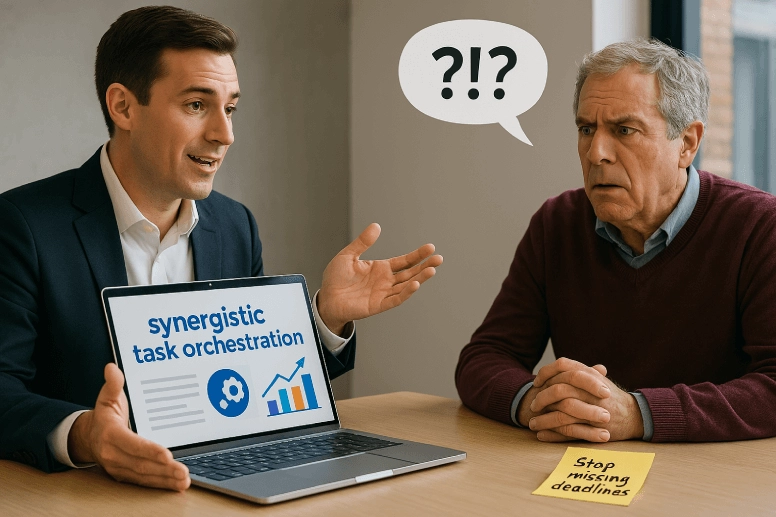7 Signs Your Team's Messaging Needs a Tune-Up
- Sign #1: Your Team Gives Wildly Different Answers About What Makes You Special
- Sign #2: Nobody Is Reading Your Technical Case Studies
- Sign #3: New Hires Take Forever to "Get" Your Messaging
- Sign #4: Your Marketing Team Creates Content Nobody Uses
- Sign #5: You Keep Losing to Inferior Competitors
- Sign #6: You Measure Messaging Success by Volume, Not Impact
- Sign #7: You Don’t Sound Like Your Customers
- Getting Back on Track: The Messaging Realignment Playbook
- When You Know Your Messaging Is Working
Have you ever sat through a meeting where various departments describe your company's value proposition? If it sounds like they are giving elevator pitches in entirely different buildings, that's a glaring red flag—your team's messaging has gone off the rails.
Messaging isn't exactly glamorous. There’s no award for "Most Coherent Value Proposition,” but that doesn’t mean it’s not critical.
Your value proposition is the foundation of your messaging, and when your messaging falls apart, that foundation cracks, and everything else is bound to follow. Customer acquisition costs skyrocket, sales hit the doldrums, and team morale tanks, all because nobody knows what story they're supposed to be telling (and selling) anymore.
In this article, we’ll look at seven giveaway signs that your company's messaging desperately needs attention. If you spot more than two of these in your organization, you've got some work to do.
Sign #1: Your Team Gives Wildly Different Answers About What Makes You Special
Try this at your office: ask five people from separate departments to define what sets your company apart from competitors. Then brace yourself.
Imagine a marketing agency running this simple exercise. Here’s what could happen:
- The creative team thinks they’re selling "award-winning design thinking".
- The account managers believe their "24/7 client response" is the differentiator.
- The CEO is convinced clients choose them for their "proprietary campaign methodology".
- The sales team pitch their "cross-platform integration capabilities".
- The analysts stress their "data-driven decision making".
That would certainly explain why pitch meetings feel scattered.
All these things might well be true, but if there’s no alignment on the primary differentiator, then everyone is pulling in opposing directions. Messaging breakdowns like this are often a sign of weak cross-communication and a lack of strong team dynamics, where departments are operating in silos, rather than working toward a unified brand story.
The fix isn't complicated, but it requires painful choices. You can't be equally exceptional at everything. Force your leadership team to prioritize. What’s the one thing that truly sets you apart? Everything else then becomes supporting evidence, not the headline.
Sign #2: Nobody Is Reading Your Technical Case Studies
Case studies should be your greatest sales weapons. So, why do most of them collect digital dust?
Take a hard look at your case studies. Do they read like engineering specifications? Do they focus more on what you did than on what the customer achieved? Are they forgettable?
The problem with most case studies isn't the solutions or results—it’s the storytelling. Case studies usually follow the same (boring) format:
- Company X needed our product
- We installed our product
- The specifications of our product are impressive
- The customer was satisfied
Yawn.
Great case studies follow another structure:
- Customer had a painful, relatable problem (with specific consequences)
- They tried other approaches that failed (creating tension)
- Together, we developed a solution (showing partnership)
- Here's what changed for their business, not just the department that bought from us (quantifiable transformation)
- A direct quote from the customer about the impact (emotional payoff)
That tells a story, and stories sell. Specifications don't.
Sign #3: New Hires Take Forever to "Get" Your Messaging
New employees are the canaries in your messaging coal mine. They don't have years of company context to fill in the blanks of a broken messaging framework.
A software company notices that its new sales reps aren't closing deals until their fifth or sixth month on the job, while veterans consistently close within their first two to three months. The instinct is to blame the hiring process or training program, but the real culprit is the chaotic messaging.
Exit interviews at this company reveal that new hires were getting whiplash from conflicting directions:
- Product marketing highlighted the platform's ease of use.
- Sales leaders pushed them to focus on ROI metrics.
- Customer success told them to highlight the support experience.
- The CEO wanted them to push the company's "visionary approach".
Without a messaging hierarchy that clearly showed which messages mattered most for varying buyer personas, those poor reps were drowning in options.
The solution is clarity. It’s certainly not more training. All the company would need to do is draft a simple one-page "messaging map" showing:
- Primary message for each buyer persona
- Top three supporting points (in priority order)
- Evidence that made those points credible
- Common objections and recommended responses
You don’t need a 50-page messaging bible. But what you do need is a centralized, easily accessible resource where teams can find and align on key messaging. A well-structured knowledge base—like the one you can set up in Flowlu—gives everyone—especially new hires—a single source of truth.
Sign #4: Your Marketing Team Creates Content Nobody Uses
Marketing develops a shiny new sales deck. Sales ignores it and sticks to their own materials. Sound familiar?
This isn't about departmental rivalry—it's about a messaging disconnect. When your teams in the field create "shadow assets," they're giving you crucial information: the official messaging doesn't work in real-world situations.
A B2B company spends $50,000 on a messaging refresh, complete with beautiful sales materials. Three months later, they discover that salespeople are still using their old, homemade presentations. Why? The new messaging sounded great in the boardroom but collapsed in client meetings. It addressed problems clients didn't prioritize and ignored the objections they actually raised.
The solution is listening to your teams that are facing the customers. They're not rejecting official messaging out of stubbornness; they're trying to do their jobs and make money. Messaging only works when teams build it together. Tools like Flowlu, which bring marketing, sales, and project teams into one workspace, can help create that shared alignment. Without cross-team collaboration, marketing talks at sales instead of with them, and sales tunes it out.
Smart companies are now involving sales teams before finalizing messaging frameworks. Some even require "field testing" where new messaging must be used in at least 10 customer interactions before it's completed.
Sign #5: You Keep Losing to Inferior Competitors
Sometimes, the best product loses. When that happens consistently, your messaging, not your offering, may be the problem.
A healthcare software company is struggling to win deals. It can’t understand why it’s losing bids to lesser competitors. Its post-mortem process focuses on feature gaps and pricing concerns. But when it interviews prospects who chose competitors, another story emerges.
What’s the real issue here? Their messaging positions them as the "comprehensive enterprise solution" with "maximum configuration options" and "extensive capabilities." The problem is that their competitors are promising "implementation in 60 days or less" and "results within the first quarter."
The company has superior technology, but it promises complexity when customers want simplicity and speed. Its messaging emphasizes what matters to its product team, not what matters to exhausted healthcare administrators trying to solve immediate problems.
They had all the right features, but the framing led to a total disconnect with decision-makers. A stronger stakeholder communication strategy would have helped them tie in their offering to what influenced buying decisions.
The lesson? You're not losing on capabilities; you're losing because you're emphasizing the wrong capabilities.
Sign #6: You Measure Messaging Success by Volume, Not Impact
How do you know if your messaging is working? Too many companies answer with metrics like:
- Number of new brochures
- Email open rates
- Website traffic
- Social media engagement
These measure activity, they don’t gauge outcomes. They tell you if people are seeing your messaging, not if it's changing their behavior.
A financial services firm is tracking "content production velocity" as their primary messaging metric. They celebrate creating 30% more white papers and case studies than the previous year. But their sales conversion rate has in fact dropped. They’re creating more content, but it’s less effective.
Meaningful messaging metrics connect to business outcomes:
- Decrease in time-to-decision for prospects
- Improvement in qualified lead conversion rates
- Reduction in "education time" during the sales process
- Competitive win rate changes
- Customer retention and expansion statistics
Rather try tracking a unique "messaging clarity score" by asking new prospects to identify what they thought your company did after their first exposure to your marketing materials. If less than 70% can accurately describe your value proposition, you know you have a messaging problem to fix.
More companies are realizing that outdated performance metrics don’t cut it anymore. Instead of tracking content volume, they’re using CRM and marketing automation—like the kind integrated into Flowlu—to quantify the real impact of messaging, like how it shortens sales cycles, improves conversion rates, and increases retention.
Sign #7: You Don’t Sound Like Your Customers
Do your customers feel like your team is speaking Martian? You're not losing deals because your product is bad, but because you're not connecting with them in their own language. Your customers aren’t glazing over in sales meetings because they don’t care. They just don’t recognize themselves or their problems in what they’re hearing.
Think about the marketing materials on your sales team’s tablets. You know, the ones filled with industry jargon and aspirational language that don't relate to how customers really experience their problems? These might appeal to people inside your organization, not those outside of it.
For example, a software company is selling a project management tool. Their solutions team wants to push phrases like, “synergistic task orchestration,” but their customers just want to keep their heads above water. They’re simply saying:
- "I'm getting swallowed up in spreadsheets."
- "My team doesn't know what they're supposed to be working on."
- "We're constantly missing deadlines."
Where is the problem? The company’s descriptions are correct, they just don’t sound like the customer. Messaging that appeals to internal stakeholders instead of real buyers causes unnecessary friction. Prospects tune out before they even reach a sales call, and deals are lost before they even begin.
The fix? Stop talking, and start listening.
If you want to make a sale, speak their language. Review sales calls, customer emails, and support tickets. Pay attention to how customers communicate their challenges and mirror their words in your messaging.
If your marketing doesn’t sound like something a real customer would say, it’s time for a rewrite.
Getting Back on Track: The Messaging Realignment Playbook
If you've recognized several warning signs, don't panic. Every growing company experiences messaging drift. The key is addressing it methodically:
- Audit your current state. Collect all versions of your messaging from across the organization. Interview team members about what they think your core value proposition is. Review won/lost deal analyses for patterns.
- Return to customer truth. Talk to your best customers. Not just the friendly ones, but the ones who get the most value from your offering. Why did they really choose you? What would they miss most if you disappeared? Their answers rarely match your marketing materials.
- Make hard choices about priorities. You can't emphasize everything equally. Force rankings of your differentiators and value propositions based on what actually matters to customers and what you can credibly deliver better than alternatives.
- Build simple tools, not comprehensive documents. A one-page messaging framework that everyone uses—stored in a shared workspace like Flowlu’s knowledge base—beats a beautiful 50-page guide that collects digital dust. Focus on creating practical tools for specific situations rather than exhaustive messaging bibles.
- Focus on improving internal communication. Look inward. If your team struggles to communicate, especially under pressure, give them the tools to talk to each other. Clear internal communication carries through to external conversations.
- Institute feedback loops. Formulate structured ways for customer-facing teams to provide regular input on what's working and what's not. Make messaging a two-way street, not a one-way broadcast.
When You Know Your Messaging Is Working
Good messaging doesn't call attention to itself, it simply makes everything else work better. You'll know your messaging has improved when:
- Customer conversations focus more on fit and implementation than on explaining what you do
- Team members can confidently describe your value in their own words while maintaining consistency
- Content gets used instead of recreated by individual departments
- New hires become productive faster
- You win more of the deals you should win
- Customer retention improves because expectations set during sales correlate with actual experience
The most successful companies treat messaging as a strategic asset, not a marketing exercise. They understand that in a world of overwhelming choice and information, clarity is a competitive advantage, not just a nice to have.
The companies that win don't necessarily have better products or services, but they are telling a clearer, more compelling story about why those products and services matter. With these tips, yours can, too.
If different departments give conflicting answers about what sets your company apart, new hires struggle to grasp messaging, or marketing materials go unused, it’s a sign your messaging needs a realignment.
If your case studies and sales materials focus on features rather than customer pain points and outcomes, they won’t engage your audience. Refocus messaging on real customer stories and measurable results.
Involve sales teams in the messaging process early. Test new messaging in real customer interactions before finalizing, ensuring it addresses actual objections and priorities.
Move beyond vanity metrics like content volume and email opens. Track conversion rates, time-to-close, and whether prospects clearly understand your value proposition after first contact.


















